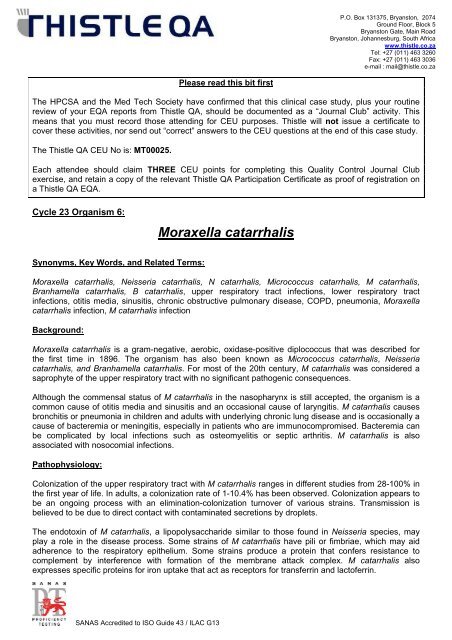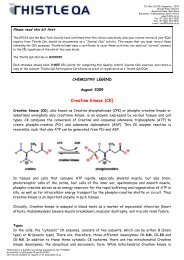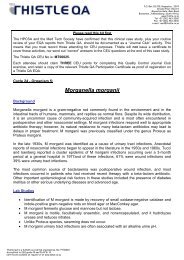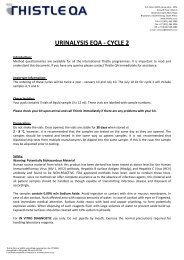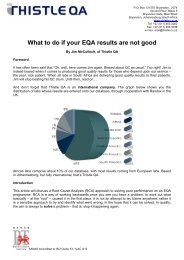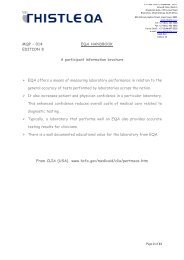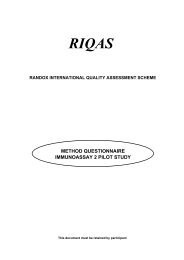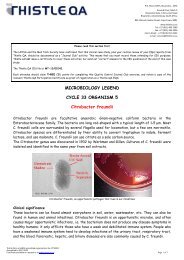Moraxella catarrhalis - Thistle QA
Moraxella catarrhalis - Thistle QA
Moraxella catarrhalis - Thistle QA
Create successful ePaper yourself
Turn your PDF publications into a flip-book with our unique Google optimized e-Paper software.
P.O. Box 131375, Bryanston, 2074<br />
Ground Floor, Block 5<br />
Bryanston Gate, Main Road<br />
Bryanston, Johannesburg, South Africa<br />
www.thistle.co.za<br />
Tel: +27 (011) 463 3260<br />
Fax: +27 (011) 463 3036<br />
e-mail : mail@thistle.co.za<br />
Please read this bit first<br />
The HPCSA and the Med Tech Society have confirmed that this clinical case study, plus your routine<br />
review of your E<strong>QA</strong> reports from <strong>Thistle</strong> <strong>QA</strong>, should be documented as a “Journal Club” activity. This<br />
means that you must record those attending for CEU purposes. <strong>Thistle</strong> will not issue a certificate to<br />
cover these activities, nor send out “correct” answers to the CEU questions at the end of this case study.<br />
The <strong>Thistle</strong> <strong>QA</strong> CEU No is: MT00025.<br />
Each attendee should claim THREE CEU points for completing this Quality Control Journal Club<br />
exercise, and retain a copy of the relevant <strong>Thistle</strong> <strong>QA</strong> Participation Certificate as proof of registration on<br />
a <strong>Thistle</strong> <strong>QA</strong> E<strong>QA</strong>.<br />
Cycle 23 Organism 6:<br />
<strong>Moraxella</strong> <strong>catarrhalis</strong><br />
Synonyms, Key Words, and Related Terms:<br />
<strong>Moraxella</strong> <strong>catarrhalis</strong>, Neisseria <strong>catarrhalis</strong>, N <strong>catarrhalis</strong>, Micrococcus <strong>catarrhalis</strong>, M <strong>catarrhalis</strong>,<br />
Branhamella <strong>catarrhalis</strong>, B <strong>catarrhalis</strong>, upper respiratory tract infections, lower respiratory tract<br />
infections, otitis media, sinusitis, chronic obstructive pulmonary disease, COPD, pneumonia, <strong>Moraxella</strong><br />
<strong>catarrhalis</strong> infection, M <strong>catarrhalis</strong> infection<br />
Background:<br />
<strong>Moraxella</strong> <strong>catarrhalis</strong> is a gram-negative, aerobic, oxidase-positive diplococcus that was described for<br />
the first time in 1896. The organism has also been known as Micrococcus <strong>catarrhalis</strong>, Neisseria<br />
<strong>catarrhalis</strong>, and Branhamella <strong>catarrhalis</strong>. For most of the 20th century, M <strong>catarrhalis</strong> was considered a<br />
saprophyte of the upper respiratory tract with no significant pathogenic consequences.<br />
Although the commensal status of M <strong>catarrhalis</strong> in the nasopharynx is still accepted, the organism is a<br />
common cause of otitis media and sinusitis and an occasional cause of laryngitis. M <strong>catarrhalis</strong> causes<br />
bronchitis or pneumonia in children and adults with underlying chronic lung disease and is occasionally a<br />
cause of bacteremia or meningitis, especially in patients who are immunocompromised. Bacteremia can<br />
be complicated by local infections such as osteomyelitis or septic arthritis. M <strong>catarrhalis</strong> is also<br />
associated with nosocomial infections.<br />
Pathophysiology:<br />
Colonization of the upper respiratory tract with M <strong>catarrhalis</strong> ranges in different studies from 28-100% in<br />
the first year of life. In adults, a colonization rate of 1-10.4% has been observed. Colonization appears to<br />
be an ongoing process with an elimination-colonization turnover of various strains. Transmission is<br />
believed to be due to direct contact with contaminated secretions by droplets.<br />
The endotoxin of M <strong>catarrhalis</strong>, a lipopolysaccharide similar to those found in Neisseria species, may<br />
play a role in the disease process. Some strains of M <strong>catarrhalis</strong> have pili or fimbriae, which may aid<br />
adherence to the respiratory epithelium. Some strains produce a protein that confers resistance to<br />
complement by interference with formation of the membrane attack complex. M <strong>catarrhalis</strong> also<br />
expresses specific proteins for iron uptake that act as receptors for transferrin and lactoferrin.<br />
SANAS Accredited to ISO Guide 43 / ILAC G13
P.O. Box 131375, Bryanston, 2074<br />
Ground Floor, Block 5<br />
Bryanston Gate, Main Road<br />
Bryanston, Johannesburg, South Africa<br />
www.thistle.co.za<br />
Tel: +27 (011) 463 3260<br />
Fax: +27 (011) 463 3036<br />
e-mail : mail@thistle.co.za<br />
Humeral responses against M <strong>catarrhalis</strong> appear to be age-dependent, with the titre of immunoglobulin<br />
G (IgG) gradually increasing in children. Antibody responses to outer-membrane proteins have been<br />
obtained, predominantly in the IgG3 subclass.<br />
Frequency:<br />
In the US, M <strong>catarrhalis</strong> is the third most common cause of otitis media and sinusitis in children<br />
(following Streptococcus pneumoniae and Haemophilus influenzae). M <strong>catarrhalis</strong> is estimated to be<br />
responsible for 3-4 million cases of otitis media annually, with an associated direct or indirect health care<br />
cost of $2 billion each year.<br />
Mortality/Morbidity:<br />
The most significant infections caused by M <strong>catarrhalis</strong> are upper respiratory tract infections, including<br />
otitis media and sinusitis in children and lower respiratory tract infections in adults. Infections with M<br />
<strong>catarrhalis</strong> in adults are more common if underlying conditions are present, especially in elderly persons.<br />
In a study of 42 cases of pneumonia with M <strong>catarrhalis</strong> isolated as single agent in sputum cultures, the<br />
mortality rate attributable to the underlying problems within 3 months of pneumonia was 45%.<br />
Sex:<br />
In one study involving adult patients, the male-to-female ratio was 1.6:1.<br />
Age:<br />
Infections with M <strong>catarrhalis</strong> may occur at any age. Although colonization is more commonly observed in<br />
children, only a small percentage of positive cultures findings have clinical significance in the paediatric<br />
population. In one study, 9% of positive culture findings from children younger than 5 years and 33% of<br />
isolates from children aged 6-10 years were found to be clinically significant. However, all culture results<br />
positive for M <strong>catarrhalis</strong> had clinical importance in adults.<br />
CPD Questions:<br />
1. What is your own lab’s male: female ratio in isolating M. <strong>catarrhalis</strong><br />
2. Discuss and consider the “attack” mechanisms of M. <strong>catarrhalis</strong>.<br />
SANAS Accredited to ISO Guide 43 / ILAC G13


